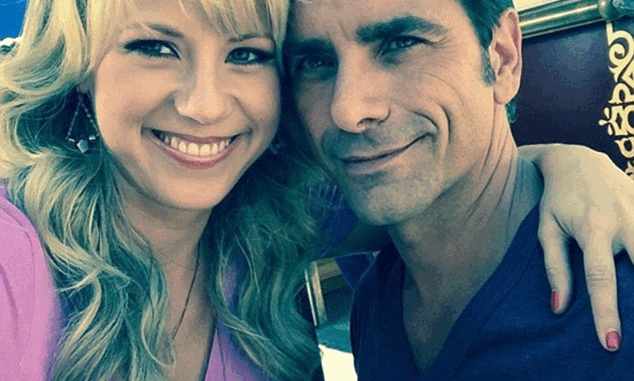
When Fuller House first hit Netflix, fans expected a fun, family-friendly reboot filled with nostalgia, laughter, and a few classic “you got it, dude” moments. But what no one expected was a bold move that would redefine the show’s legacy: Stephanie Tanner’s coming-out storyline in Season 4.
This pivotal moment wasn’t just another emotional scene — it became a cultural turning point for LGBTQ+ visibility in mainstream sitcoms. Let’s break down how Stephanie’s journey became one of the most important developments in Fuller House and why it still matters today.
1. Stephanie Tanner’s Journey Comes Full Circle
Stephanie Tanner, played by Jodie Sweetin, was always the wild, free-spirited middle child of the Tanner family. From her sassy one-liners in Full House to her mature, soulful moments in Fuller House, her evolution felt real and relatable.
By Season 4, Stephanie’s storyline took a surprising and deeply meaningful turn — she opened up about her sexuality in a way that was subtle yet powerful. Fans immediately praised the show for how authentically it handled her revelation.
2. How Fuller House Built Up to Stephanie’s Coming Out
The beauty of Stephanie’s arc lies in its buildup. Instead of forcing her sexuality into a single dramatic scene, the show layered her journey through personal reflection, dialogue, and quiet emotional moments.
From early seasons, Stephanie was shown struggling to find her identity after years of feeling overshadowed. Her story of self-discovery — as a woman, an artist, and eventually as someone exploring her sexuality — felt organic, not performative.
3. The Scene That Changed Everything
In Season 4, Stephanie shares an intimate, heartfelt conversation that subtly yet clearly confirms her attraction beyond traditional norms.
She doesn’t label herself outright — and that’s what makes it powerful. Her openness to love, no matter gender, reflects the fluid and modern understanding of sexuality today.
That moment wasn’t about shock value — it was about honesty. It showed that love, identity, and self-acceptance can coexist naturally within a mainstream family sitcom.
4. Why This Storyline Matters
Why does this matter so much? Because Fuller House isn’t just any show. It’s a globally beloved family sitcom with multi-generational appeal. For many, it’s comfort TV — and that makes Stephanie’s coming out even more impactful.
By bringing LGBTQ+ representation into such a familiar and wholesome universe, Fuller House helped normalize conversations that might otherwise feel uncomfortable in family spaces. It reminded viewers that inclusion belongs everywhere — even in the Tanners’ living room.

5. A Win for Authentic LGBTQ+ Representation
Representation isn’t just about visibility; it’s about authenticity. Stephanie’s story wasn’t a stereotype or a plot twist — it was genuine, emotional, and consistent with her character’s journey.
Rather than being reduced to a “token” identity, Stephanie remained her quirky, loving, and strong-willed self. Her sexuality didn’t define her — it enriched her. That’s real representation.
6. Jodie Sweetin’s Courage Behind the Scenes
Jodie Sweetin has always been open about her personal struggles and growth. Her willingness to explore this storyline gave it emotional depth and credibility.
In interviews, she’s expressed her support for inclusive storytelling and the importance of showing characters that reflect real people’s lives. Her nuanced portrayal turned what could’ve been a gimmick into a heartfelt moment of truth.
7. Fans’ Emotional Reactions Online
When the episode aired, fans took to social media to share their love and appreciation.
LGBTQ+ viewers and allies praised Netflix for taking the leap. Many shared personal stories about how Stephanie’s openness helped them feel seen.
It wasn’t just a TV moment — it became a movement within the fandom, inspiring fan art, discussions, and heartfelt tributes to Stephanie Tanner’s growth.
8. Fuller House and Its Progressive Shift
The original Full House from the late ’80s was known for being wholesome, traditional, and family-centric. But Fuller House dared to evolve with the times.
By Season 4, it embraced modern family dynamics — single parenting, diverse relationships, fertility struggles, and now, LGBTQ+ inclusion. This wasn’t just a nostalgic reboot anymore; it was a reflection of today’s world.
9. The Impact on Younger Viewers
Representation on-screen matters, especially for younger audiences. When kids and teens see characters like Stephanie being open about who they are, it sends a powerful message: You are normal. You are loved. You belong.
This subtle inclusion teaches acceptance without lecturing — the best kind of lesson a show can give.
10. The Importance of Normalizing, Not Highlighting
One of the smartest moves Fuller House made was not making a spectacle out of Stephanie’s sexuality.
The show treated it like any other part of her life — with respect and warmth. That approach helps normalize LGBTQ+ identities rather than sensationalize them, showing that love is love, period.
11. The Broader Impact on Hollywood
Stephanie Tanner’s storyline may seem small in the grand scope of Hollywood, but its ripple effects were significant.
By weaving inclusive storytelling into a mainstream family sitcom, Fuller House joined a growing list of shows — like Modern Family and Schitt’s Creek — that challenge outdated norms and promote empathy through humor and heart.
12. The Cast’s Support for Inclusion
The Fuller House cast, including Candace Cameron Bure and Andrea Barber, have been vocal about supporting diverse storytelling.
Behind the scenes, the team worked to ensure the moment felt natural, not forced. This collaboration between cast and writers helped create a respectful, heartfelt narrative that fans continue to celebrate.
13. Breaking Stereotypes Through Comedy
Comedy has power — it opens hearts where words alone can’t.
By using humor, warmth, and genuine emotion, Fuller House broke stereotypes about what an LGBTQ+ storyline can look like. It didn’t preach; it simply showed.
That’s why it worked — because it made inclusion feel normal, not “different.”
14. Stephanie’s Story Beyond Labels
In a world obsessed with labeling identities, Fuller House took a refreshing approach. Stephanie didn’t have to define herself in exact terms.
Her story spoke to a larger truth: human connections transcend labels. Whether you’re straight, gay, or somewhere in between, love and authenticity are what matter most.
15. How Fuller House Paved the Way for Future Sitcoms
After Stephanie’s storyline aired, several family-friendly shows followed suit, embracing diversity more openly.
By setting an example, Fuller House proved that inclusive storytelling can thrive in mainstream television without alienating audiences. It opened the door for future sitcoms to explore similar themes — with heart, humor, and humanity.
16. The Real Reason This Moment Was a Game-Changer
The reason Stephanie’s coming out scene was a game-changer is simple: it made history in an unexpected place.
Few people expected a wholesome, family-centric series like Fuller House to deliver such a progressive message — and that surprise made it even more powerful.
It wasn’t loud. It wasn’t flashy. It was human. And sometimes, quiet revolutions make the loudest impact.
17. Looking Ahead: Could Fuller House Explore More LGBTQ+ Stories?
While Fuller House officially ended with Season 5, fans still hope for future spin-offs or specials that could further explore LGBTQ+ storylines.
With today’s growing demand for inclusive content, it’s entirely possible that Stephanie’s story could inspire future projects or deeper exploration in the Full House universe.
18. Lessons We Can Learn from Stephanie Tanner
Stephanie’s story teaches us more than tolerance — it teaches us empathy.
It reminds us that understanding begins at home, in conversations around the dinner table, and in the stories we share with each other.
Her courage inspires others to embrace their truth, no matter how long it takes to get there.
19. The Legacy of Fuller House’s Inclusivity
Long after the credits rolled, Fuller House left a mark on television history.
It proved that family entertainment can evolve — and that love, acceptance, and authenticity never go out of style.
In a world that often divides, the Tanner family reminded us that hearts are meant to stay open.
Conclusion
Stephanie Tanner’s coming out in Fuller House Season 4 wasn’t just another TV moment — it was a breakthrough in how family sitcoms handle identity, love, and acceptance.
It showed that inclusion doesn’t have to be loud or forced — it can be gentle, heartfelt, and real.
Through her story, millions felt seen, validated, and celebrated. That’s what true representation looks like. And that’s why Fuller House will always hold a special place in LGBTQ+ television history.
FAQs
1. Did Stephanie Tanner officially come out in Fuller House?
Yes. While the moment was subtle, it confirmed Stephanie’s openness about her sexuality, reflecting modern LGBTQ+ representation.
2. How did fans react to Stephanie’s coming-out scene?
Fans overwhelmingly supported it, praising Netflix for its authentic, heartfelt approach to inclusion.
3. Was this storyline based on Jodie Sweetin’s real life?
No, but Sweetin supported the storyline and has been vocal about advocating for inclusive and compassionate storytelling.
4. Did Fuller House receive any backlash for the storyline?
While some conservative viewers disagreed, most praised the show for its respectful handling of LGBTQ+ themes.
5. Will there be more LGBTQ+ stories in the Fuller House universe?
There’s no official confirmation, but fans continue to hope for more inclusive storytelling in any future spin-offs or reunions.
